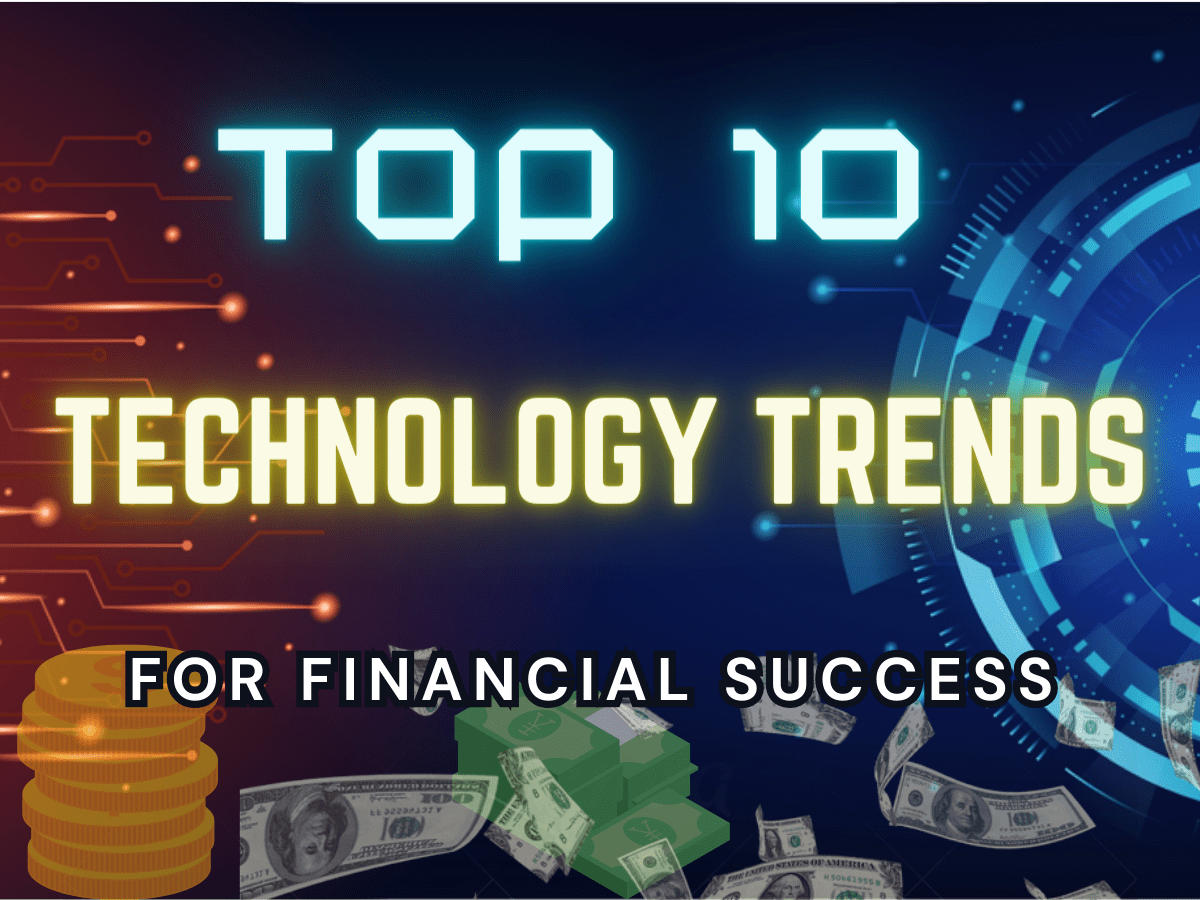
In 2023, technology stands as the powerful driving force shaping industries and individual experiences. Staying ahead of technological changes is not an option; it’s a pure necessity for all organizations which aim to outpace competitors available in the market. In this comprehensive article, we will dive into all the crucial technology trends that are set to define 2024 and beyond it, which unveil opportunities for businesses and individuals alike.
As AI continously progresses with breakthroughs in machine learning algorithms, its impact diverges into healthcare, finance, and various sectors. The IoT’s growth reaches to smart cities and homes, accompanied by increased concerns and innovative security solutions. The evolution of 5G goes beyond telecommunications, manufacturing and presenting new avenues for applications and services. In AR and VR, technological advancements opens the way for transformative applications in gaming, education, and many more. Together, these trends make the foundation for the potential monetization sources in 2024.
Understanding and tracking the technology trends is not only a matter of survival but a ultimate gateway to success. Businesses that uses emerging technologies always gain a competitive edge, while individuals get equipped with the right skills helps them to navigate a tech-driven world with confidence. The relationship between technological advancements and financial opportunities is the crux of our exploration on this article.
In today’s dynamic landscape, be updated about technology trends is important for organizations who are eagerly trying to outweigh the existing competitors. Staying ahead of improvements ensures that businesses are well positioned to harness emerging opportunities, innovate, and adapt to evolving consumer wants and needs. Moreover, for individuals, understanding about all technology updates is a pathway to professional career growth, which ensures relevance in an rapid-changing job market. Overall, the relevance of understanding the latest technology trends extends beyond mere awareness—it is a strategic imperative for sustained success for both individuals and companies.

In 2023, breakthroughs in machine learning algorithms are revolutionizing artificial intelligence (AI). Quantum computing, reinforcement learning, and transformer models are driving unprecedented advancements, impacting industries such as healthcare and finance. Staying abreast of these breakthroughs is crucial for businesses and individuals, offering strategic insights and a competitive edge.
In 2024, machine learning algorithms are poised to achieve remarkable breakthroughs, pushing the boundaries of what AI can accomplish. From advancements in natural language processing to strides in computer vision and reinforcement learning, the realm of possibilities expands exponentially.
1. Healthcare:
Enhanced diagnostics and personalized treatment plans.
Drug discovery and development accelerated through AI algorithms.
Predictive analytics for patient outcomes and resource optimization.
2. Finance:
Algorithmic trading and risk management for financial institutions.
Fraud detection and cybersecurity powered by AIdriven models.
Personalized financial advice through roboadvisors.
3. Manufacturing:
Predictive maintenance, reducing downtime and optimizing operations.
Quality control improvement using machine vision and AI analytics.
Supply chain optimization through demand forecasting algorithms.
4. Retail:
Customer behavior analysis for personalized shopping experiences.
Inventory management and demand forecasting through AI.
Chatbots and virtual assistants enhancing customer service.
5. Education:
Personalized learning paths and adaptive educational content.
Automated grading and assessment tools for educators.
AIdriven virtual tutors for individualized student support.
6. Automotive:
Autonomous vehicle development and smart traffic management.
Predictive maintenance for vehicles, reducing breakdowns.
Enhanced driver assistance systems for safety and convenience.
7. Marketing:
Targeted advertising and customer segmentation using AI.
Sentiment analysis for understanding customer preferences.
AIpowered chatbots improving customer engagement.
8. Telecommunications:
Network optimization and predictive maintenance.
Fraud detection and security enhancements through AI.
AIdriven customer service for quicker issue resolution.
As AI takes center stage, ethical considerations become paramount. The ethical dilemmas in AI development, including issues of bias, privacy, and responsible AI practices, are integral to our exploration. Navigating these ethical considerations is not just a moral imperative but a crucial aspect of sustainable and profitable AI deployment.

The growth and expansion of Internet of Things (IoT) devices in 2023 are reshaping how we interact with technology. With an increasing number of connected devices, from smart homes to industrial sensors, IoT is creating a seamless network of data exchange. This proliferation presents opportunities for enhanced efficiency and convenience, but it also brings challenges related to security and data privacy. Navigating this IoT landscape is essential for businesses and individuals aiming to harness the full potential of this interconnected ecosystem.
Smart cities are leveraging IoT for enhanced efficiency, sustainability, and citizen services. Meanwhile, smart homes are becoming more interconnected, offering unparalleled convenience.
The integration of the Internet of Things (IoT) in smart cities and homes is revolutionizing urban living and domestic environments. In smart cities, IoT facilitates efficient public services, from intelligent traffic management to waste disposal. In homes, IoT-driven devices enhance automation and connectivity, offering residents unprecedented control over their living spaces. While this integration promises convenience and sustainability, it also raises concerns about privacy and cybersecurity. Striking a balance between innovation and safeguarding personal information is crucial as IoT continues to shape the future of urban and domestic landscapes.
1. Security Concerns: Risks like data breaches and unauthorized access due to numerous connected devices.
2. Interoperability Issues: Lack of standardized protocols hampers seamless communication among diverse IoT devices.
3. Scalability Challenges: Increasing connected devices strain network bandwidth and data management.
4. Data Privacy Risks: Extensive user data collection raises concerns about privacy and potential misuse.
5. Limited Power Resources: Many IoT devices operate on constrained power sources, impacting consistent connectivity over time.
1. Robust Security Measures: Strong encryption and secure access controls address IoT’s security vulnerabilities.
2. Standardization Efforts: Industry-wide initiatives establish common standards, enhancing interoperability.
3. Scalable Architectures: Designing scalable systems ensures optimal performance with a growing number of IoT devices.
4. Privacy by Design: Incorporating privacy features from the outset ensures responsible data handling in IoT solutions.
5. Energy-Efficient Designs: Developing IoT devices with optimized power consumption extends device lifecycles and reduces environmental impact.

The evolution of 5G technology signifies a substantial advancement in connectivity, offering faster speeds and lower latency. With a global expansion, it transforms communication, impacting industries like telecommunications, manufacturing, and healthcare. Beyond mobile internet speed, 5G facilitates innovations such as smart cities and IoT. However, challenges in infrastructure and security must be addressed for equitable access and utilization of its capabilities. This evolution is crucial for businesses and individuals aiming to capitalize on the diverse opportunities 5G presents.
1. Telecommunications:
– 5G enables faster data speeds, low latency, and enhanced connectivity for advanced communication services.
– Telecom companies deploy 5G infrastructure to support a growing number of 5G-enabled devices.
2. Manufacturing:
– Smart factories leverage 5G for real-time monitoring, control, and automation of production processes.
– Enhanced connectivity improves efficiency, reduces downtime, and supports the deployment of IoT devices in manufacturing.
3. Healthcare:
– 5G facilitates improved telemedicine services, enabling high-quality video consultations and remote patient monitoring.
– Faster data transfer enhances medical professionals’ ability to access and share patient information seamlessly.
4. Transportation:
– Adoption of 5G in transportation supports advancements in autonomous vehicles by providing reliable, low-latency communication.
– Improved connectivity enhances navigation systems, traffic management, and overall transportation efficiency.
5. Smart Cities:
– 5G is integral to smart city initiatives, enabling the development of connected infrastructure and public services.
– Applications include smart street lighting, waste management, public safety, and efficient city planning.

Advancements in Augmented Reality (AR) and Virtual Reality (VR) technology are driving transformative experiences across industries. In 2023, AR is pushing the boundaries of reality by seamlessly blending digital elements with the real world. This is evident in applications like immersive gaming, interactive education, and innovative marketing.
VR, on the other hand, is evolving with improved hardware and realistic simulations. From immersive virtual meetings to therapeutic VR experiences, the technology is expanding its reach. These advancements open doors to new possibilities, presenting opportunities for businesses and individuals to explore and capitalize on the immersive potential of AR and VR. However, challenges such as user adoption and technical constraints continue to shape the trajectory of these technologies.
1. Gaming Revolution:
AR and VR are reshaping the gaming landscape, offering players unprecedented levels of immersion. In AR, games like Pokémon GO leverage real-world environments, making gaming a dynamic outdoor experience. VR, with its realistic simulations and 360-degree environments, provides an unparalleled level of engagement in genres ranging from action to simulation.
2. Educational Frontiers:
AR and VR technologies are transforming education, making learning more interactive and captivating. In AR, applications overlay educational content onto the real world, allowing students to explore subjects like never before. VR, on the other hand, enables virtual field trips, historical reenactments, and realistic simulations, providing students with hands-on experiences beyond traditional classrooms.
3. Architectural Visualization:
In industries like architecture, AR and VR play a pivotal role in visualizing designs. AR allows architects to superimpose digital models onto physical spaces, aiding in on-site decision-making. VR complements this by offering immersive virtual walkthroughs of architectural designs, allowing clients to experience spaces before they are constructed.
4. Healthcare Simulation:
Both AR and VR find applications in healthcare, enhancing medical training and patient care. AR assists surgeons with real-time data overlays during surgeries, improving precision. VR, on the other hand, provides realistic simulations for medical training, allowing practitioners to practice procedures in a risk-free virtual environment. These applications signify the diverse impact of AR and VR across gaming, education, architecture, and healthcare industries.
| Possibilities | Challenges |
|---|---|
| Enhanced Learning and Education: Interactive virtual experiences, spatial learning, and gamified education. | Cost of VR equipment and content creation, potential for distraction and digital divides. |
| Revolutionized Work and Collaboration: Remote co-creation in 3D environments, global teams without borders, and immersive training simulations. | Security of sensitive data in virtual workspaces, potential for social isolation and work-life balance issues. |
| Seamless Healthcare and Therapy: Virtual surgery training, remote patient monitoring, and personalized exposure therapy experiences. | Ethical considerations around data privacy and potential misuse of VR for mental health treatment. |
| Reimagined Entertainment and Storytelling: Interactive narratives, hyper-realistic gaming worlds, and blended reality experiences blurring the lines between physical and virtual. | Hardware limitations hindering immersion, potential for sensory overload and addiction to virtual worlds. |
| Empowering Accessibility and Inclusion: Virtual travel for those with physical limitations, AR overlays assisting with daily tasks, and accessible virtual experiences for all. | Ensuring affordability and equitable access to technology, combating potential discrimination within virtual environments. |

Blockchain technology, a decentralized and transparent system, is witnessing transformative developments in 2023. Smart contracts, decentralized finance (DeFi), and non-fungible tokens (NFTs) exemplify its impact on various industries. These advancements address challenges related to security, trust, and efficiency, indicating a growing integration of blockchain in diverse sectors. Staying informed about these changes is vital for those aiming to stay ahead in the evolving technological landscape.
The adoption of cryptocurrencies and decentralized finance (DeFi) is reshaping traditional financial landscapes. In 2023, the financial sector witnesses a surge in crypto acceptance, with businesses, institutions, and individuals embracing digital currencies. DeFi platforms, offering decentralized lending, borrowing, and trading, provide alternatives to traditional banking. As blockchain-based financial systems gain traction, navigating the regulatory landscape becomes crucial, influencing the future trajectory of cryptocurrencies and DeFi.
Regulatory concerns loom over the expanding realm of blockchain-based systems. As cryptocurrencies and decentralized applications gain prominence, governments globally grapple with establishing frameworks to govern these technologies. Striking a balance between fostering innovation and safeguarding against risks becomes a focal point.
The evolving regulatory landscape significantly influences the trajectory of blockchain-based systems, impacting adoption rates, market dynamics, and the overall maturation of decentralized technologies. Navigating this regulatory terrain will be pivotal for the future development and integration of blockchain systems across diverse industries.
Read these 5 tricky ways to make money from Instagram in Nepal

Innovations in renewable energy and eco-friendly technology are reshaping the landscape of sustainability. From breakthroughs in solar and wind power to advancements in energy storage and conservation, the pursuit of greener alternatives is gaining momentum. These innovations not only address the pressing challenges of climate change but also offer viable solutions for businesses and communities striving to reduce their environmental footprint. Embracing renewable energy sources and eco-friendly technologies is not just a choice; it’s a strategic move toward a more sustainable and responsible future.
Tech solutions are playing a pivotal role in addressing climate change by offering innovative approaches to environmental challenges. From data-driven precision agriculture that optimizes resource use to smart grids that enhance energy efficiency, technology is fostering sustainability. Climate-focused startups are leveraging artificial intelligence and IoT to monitor and manage environmental impact.
Additionally, advancements in carbon capture, sustainable transportation, and circular economy technologies contribute to a more resilient and eco-friendly world. As organizations integrate these solutions into their practices, the collective impact has the potential to drive meaningful progress toward mitigating climate change.

The rapidly advancing technological landscape presents a host of emerging cybersecurity threats. Sophisticated ransomware attacks, evolving phishing techniques, and vulnerabilities in IoT devices pose significant risks to organizations and individuals. State-sponsored cyber threats add a geopolitical dimension to the cybersecurity landscape, requiring heightened vigilance.
To counter these threats, organizations are adopting proactive cybersecurity measures. Advanced threat detection systems, machine learning algorithms, and artificial intelligence play crucial roles in identifying and mitigating emerging threats in real time. Regular security audits, employee training programs, and the implementation of robust encryption technologies contribute to a multi-layered defense against cyber threats. As the digital realm continues to evolve, staying ahead in cybersecurity remains imperative for safeguarding sensitive data and ensuring the resilience of digital ecosystems.
In our exploration of 2024’s tech landscape, we’ve unveiled eight key trends. However, the tech realm is dynamic, and surprises may lurk beyond our current insights.
Share your thoughts in the comments, and let’s unravel the mysteries together. Your input might just reveal the next big thing in the ever-evolving world of technology.
Q: What cybersecurity measures should businesses adopt to safeguard against emerging threats?
– A: Every Businesses should implement advanced threat detection systems, machine learning algorithms, conduct regular security audits, and provide employee training to create a robust defense against evolving cyber threats.
Q: How can individuals and businesses stay ahead in the ever-evolving tech landscape of 2024?
– A: You should be doing continuous learning, staying updated on tech trends, and investing in skill development are crucial. Networking with industry professionals and participating in relevant forums foster a proactive approach. So, remember this always.
Q: Are there potential risks associated with the rapid integration of AI, IoT, and other technologies in our daily lives?
– A: Yes, of course, risks include job displacement, privacy concerns, and ethical dilemmas. Striking a balance between innovation and responsible deployment, along with robust regulations, is essential to mitigate these risks.
Q: How can businesses prepare for the ethical considerations in AI development mentioned in the article?
– A: Prioritizing fairness, transparency, and ethical guidelines is crucial. Collaborating with industry peers, adopting responsible AI practices, and staying compliant with privacy standards are key steps.
Q: Are there potential downsides to the widespread adoption of blockchain technology and cryptocurrencies?
– A: While offering transformative benefits, challenges include regulatory uncertainties and potential misuse. Navigating these challenges involves staying informed on evolving regulations and ensuring responsible use of these technologies.
Q: Can small businesses benefit from the mentioned technology trends, or are they more suited for larger enterprises?
– A: Small businesses can indeed benefit by adopting scalable solutions based on these trends. Many technologies offer cost-effective and adaptable options, empowering small businesses to compete and innovate.
Feel free to let me know if you need any further adjustments or additions!
Also Read About :Technological Progress and Potential Future Risks
#Technology Trends To Earn Money in 2024 #Technology Trends To Earn Money in 2024 #Technology Trends To Earn Money in 2024 #Technology Trends To Earn Money in 2024 #Technology Trends To Earn Money in 2024 #Technology Trends To Earn Money in 2024